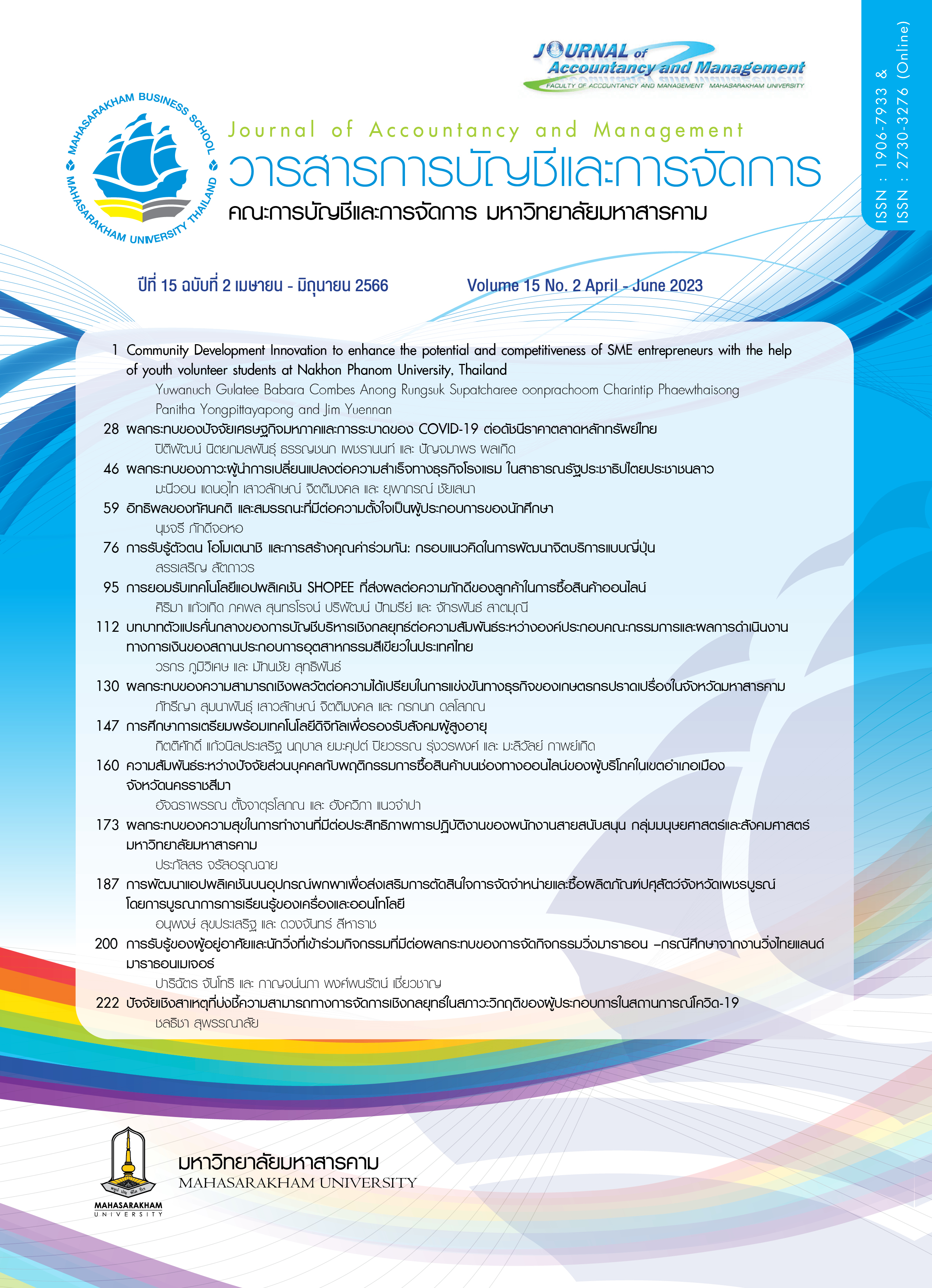ผลกระทบของความสามารถเชิงพลวัตต่อความได้เปรียบในการแข่งขัน ทางธุรกิจของเกษตรกรปราดเปรื่อง ในจังหวัดมหาสารคาม
Main Article Content
บทคัดย่อ
การวิจัยครั้งนี้มีวัตถุประสงค์ 1. เพื่อศึกษาความสามารถเชิงพลวัตของเกษตรกรปราดเปรื่อง ที่เป็นสมาชิกธนาคารเพื่อการเกษตรและสหกรณ์การเกษตร ในจังหวัดมหาสารคาม 2. เพื่อศึกษาความได้เปรียบในการแข่งขันทางธุรกิจของเกษตรกรปราดเปรื่อง ที่เป็นสมาชิกธนาคารเพื่อการเกษตรและสหกรณ์การเกษตร ในจังหวัดมหาสารคาม และ 3. เพื่อทดสอบผลกระทบของความสามารถเชิงพลวัตต่อความได้เปรียบในการแข่งขันทางธุรกิจของเกษตรกรปราดเปรื่องที่เป็นสมาชิกธนาคารเพื่อการเกษตรและสหกรณ์การเกษตร ในจังหวัดมหาสารคาม
กลุ่มตัวอย่างในการวิจัย ได้แก่ เกษตรกรปราดเปรื่อง ที่เป็นสมาชิกธนาคารเพื่อการเกษตรและสหกรณ์การเกษตร ในจังหวัดมหาสารคาม จำนวน 355 ราย เครื่องมือในการเก็บรวบรวมข้อมูล คือ แบบสอบถาม สถิติที่ใช้ในการวิเคราะห์ ข้อมูล ได้แก่ ค่าร้อยละ ค่าเฉลี่ย ส่วนเบี่ยงเบนมาตรฐาน การวิเคราะห์สหสัมพันธ์พหุคูณ การวิเคราะห์การถดถอยแบบพหุคูณ
ผลการศึกษา พบว่า เกษตรกรปราดเปรื่อง ที่เป็นผู้ประกอบการ ในจังหวัดมหาสารคามมีความคิดเห็นเกี่ยวกับความสามารถเชิงพลวัต โดยรวมมีค่าเฉลี่ยอยู่ที่ระดับมาก เมื่อวิเคราะห์รายละเอียดเป็นรายด้าน พบว่า มีค่าเฉลี่ยอยู่ในระดับมากทุกด้าน สามารถเรียงลำดับตามค่าเฉลี่ยจากมากไปน้อย 3 ลำดับแรก ได้แก่ ความสามารถในการดูดซับความรู้ รองลงมา คือ ความสามารถด้านนวัตกรรม และความสามารถในการปรับตัว ตามลำดับ ผลการศึกษาความได้เปรียบในการแข่งขันทางธุรกิจของเกษตรกรปราดเปรื่อง ในจังหวัดมหาสารคาม มีความคิดเห็นต่อความได้เปรียบในการแข่งขันโดยรวมมีค่าเฉลี่ยอยู่ในระดับมากและการวิเคราะห์ผลกระทบของความสามารถเชิงพลวัตต่อความได้เปรียบในการแข่งขันทางธุรกิจของเกษตรกรปราดเปรื่องในจังหวัดมหาสารคาม พบว่า ความสามารถเชิงพลวัต ด้านความสามารถในการดูดซับความรู้ ด้านความสามารถในการปรับตัว และด้านความสามารถด้านนวัตกรรม มีผลกระทบในเชิงบวกต่อความได้เปรียบในการแข่งขันทางธุรกิจของเกษตรกรปราดเปรื่อง อย่างมีนัยสำคัญทางสถิติที่ระดับ 0.01
Downloads
Article Details

อนุญาตภายใต้เงื่อนไข Creative Commons Attribution-NonCommercial-NoDerivatives 4.0 International License.
บทความที่ได้รับการตีพิมพ์เป็นลิขสิทธิ์ของวารสารการบัญชีและการจัดการ
ข้อความที่ปรากฏในบทความแต่ละเรื่องในวารสารวิชาการเล่มนี้เป็นความคิดเห็นส่วนตัวของผู้เขียนแต่ละท่านไม่เกี่ยวข้องกับมหาวิทยาลัยมหาสารคาม และคณาจารย์ท่านอื่นๆในมหาวิทยาลัยฯ แต่อย่างใด ความรับผิดชอบองค์ประกอบทั้งหมดของบทความแต่ละเรื่องเป็นของผู้เขียนแต่ละท่าน หากมีความผิดพลาดใดๆ ผู้เขียนแต่ละท่านจะรับผิดชอบบทความของตนเองแต่ผู้เดียว
เอกสารอ้างอิง
กรมส่งเสริมการเกษตร. (2556). คู่มือการขับเคลื่อนนโยบาย Smart Farmer และ Smart Officer. กรุงเทพฯ : กระทรวงเกษตรและสหกรณ์.
กรธวัฒน์ สกลคฤหเดช. (2559). ความสามารถเชิงพลวัต ความได้เปรียบทางการแข่งขันและความสำเร็จของธุรกิจอุตสาหกรรมอาหารแปรรูปของประเทศไทย. วารสารเกษมบัณฑิต, 17(2), 225-237.
ธัญนาฏ ญาณพิบูลย์ สุจินดา โพธิ์ไพฑูรย์ และนิติพงษ์ ส่งศรีโรจน์. (2563). ความสามารถในการใช้ความรู้และนวัตกรรมกับประเด็นที่โดดเด่นขององค์กรใหม่ในธุรกิจภาคการเกษตร. จุฬาลงกรณ์ธุรกิจปริทัศน์, 42(2), 54-72.
บุญใจ ศรีสถิตย์นรากูร. (2550). ระเบียบวิธีการวิจัย:แนวทางปฏิบัติสู่ความสำเร็จ. กรุงเทพฯ : ยูแอนด์ไอ อินเตอร์มีเดีย.
พิมกาญดา จันดาหัวดง. (2563). ความสามารถเชิงพลวัต การมุ่งเน้นความเป็นผู้ประกอบการและความสามารถทางการแข่งขัน. วารสารวิชาการ มหาวิทยาลัยราชภัฏภาคเหนือ, 11(1), 386-406.
วสุธิดา นักเกษม. (2561). ปัจจัยที่ส่งผลต่อการสร้างความได้เปรียบทางการแข่งขันของผู้ประกอบการธุรกิจบริการในเขตกรุงเทพมหานคร. Veridian E-Journal, Silpakorn University ฉบับภาษาไทยสาขามนุษยศาสตร์สังคมศาสตร์ และศิลปะ, 11(1), 2153-2154.
วิโรจน์ เจษฎาลักษณ์ และอาภัสรา สมใจ. (2563). อิทธิพลของคุณลักษณะความเป็นผู้ประกอบการในการบริหารความเสี่ยงของ เกษตรกรที่มีต่อผลประกอบการเกษตรอินทรีย์ตามบทบาทของความคิดสร้างสรรค์ในการทำการเกษตรอินทรีย์และการปรับตัวในการทำเกษตรอินทรีย์ ของเกษตรกรในจังหวัดกาญจนบุรี. วารสารวิทยาการจัดการ มหาวิทยาลัยราชภัฏอุดรธานี, 2(2), 1-12.
วัลย์จรรยา วิระกุล. (2564). ปัจจัยที่มีผลต่อความสามารถในการแข่งขันของเกษตรกรแปลงใหญ่ข้าวจังหวัดขอนแก่น. วารสารวิชาการและวิจัย มหาวิทยาลัยภาคตะวันออกเฉียงเหนือ, 11(2), 197-211.
สันติ กระแจะจันทร์. (2562). กลยุทธ์การพัฒนานวัตกรรมความได้เปรียบเชิงแข่งขันทางธุรกิจสู่ประเทศไทย 4.0, วารสารวิชาการคณะมนุษยศาสตร์และสังคมศาสตร์, 10(2), 83-94.
สุดารัตน์ พิมลรัตนกานต์. (2562). ความสามารถในการจัดการนวัตกรรมเพื่อผลการดำเนินงานขององค์กรที่ยั่งยืนของอุตสาหกรรมการเกษตรในประเทศไทย. วิทยานิพนธ์ปรัชญาดุษฎีบัณฑิต มหาวิทยาลัยศิลปากร.
สมบูรณ์ สุริยวงศ์และคณะ. (2552). ระเบียบวิธีวิจัยทางการศึกษา. กรุงเทพฯ : ศูนย์ส่งเสริมวิชาการ.
สารสนเทศข้อมูลลูกค้าธนาคารเพื่อการเกษตรและสหกรณ์การเกษตร. (2563). ระบบบริหารงานสาขา. ฐานข้อมูลงานธนาคาร. ธนาคารเพื่อการเกษตรและสหกรณ์การเกษตร.
อัจฉรา สุขกลั่น เกษราภรณ์ สุตตาพงค์ และนนทิภัค เพียรโรจน์. (2561). กลยุทธ์การสร้างความได้เปรียบทางการแข่งขันของผู้ประกอบการเกษตรอัจฉริยะ, วารสารนักบริหาร, 38(1), 91-100.
Aaker, D. A., Kumar, V., & Day, G. S. (2001). Marketing Research. New York : John Wiley and Sons.
Armstrong, J. S., & Overton, T. S. (1977). Estimating non-response bias in mail surveys. Journal of Marketing Research, 14(3), 396-402.
Hair, J., et al. (2010). Multivariate data analysis (7th ed.). Upper saddleRiver, New Jersey : Pearson Education International.
Yamane, T. (1973). Statistics: An Introductory Analysis. Third edition. New York : Harper and Row Publication.


